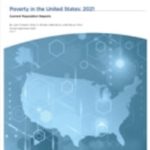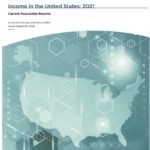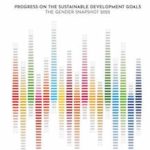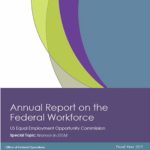 All Entries in the "Research/Study" Category
All Entries in the "Research/Study" Category

Do Biased Teacher Evaluations Contribute to the “Leaky Pipeline” of Women Faculty
A new study led by Whitney Buser, senior academic professional and associate director of academic programs in the School of Economics at the Georgia Institute of Technology investigated whether bias exists at the outset of the semester and whether backlash after grading exacerbates it.

Women Now Make Up a Majority of the College-Educated Workforce in the United States
A new study by the Pew Research Center finds that there were 31.3 million women with a bachelor’s degree or higher who were employed in the second quarter of 2022. There were 30.5 million men in the workforce who had a college degree.

Gender Differences in How Recent College Graduates Fared During the Pandemic
For 2015-16 college graduates, 12.6 percent of women reported that they had difficulty meeting essential expenses during the pandemic, compared to only 8.3 percent of men who graduated from college that year. For college-educated men, the average annual pay during the pandemic was $67,800. For college-education women, the average pay was $55,900.

The Persisting Gender Gap in Poverty Rates in the United States
In 2021, only 4.8 percent of married-couple families lived in poverty. For families headed by a single man, 12 percent of all families were poor. But for families headed by a single woman, 23 percent of all families were poor. There were more than 12 million people living below the poverty line in families headed by a single woman, including 6,474,000 children.

How Mentoring Relationships May Impact the Retention of Women Researchers in Academia
The authors analyzed more than 26,000 formal Ph.D. and postdoctoral mentoring relationships in the life sciences during the years 2000 to 2020. The authors found women tended to mentor other women and men tend to mentor other men. The data shows that trainees with women mentors were less likely to go on to become academic mentors later in their careers than trainees who had male mentors.

University Study Finds Women Legislators Are Asked to Do More for Their Constituents Than Male Legislators
A new study by scholars at Washington University in St. Louis and the University of Gothenburg in Sweden finds that women who hold elected office often are 10 percent more likely to be contacted by their constituents, and they receive 14 percent more issue requests per constituent they contact than is the case for male elected officials.

The Gender Gap in Median Income Widened in 2021
In 2021, the median income level for family households headed by a single woman was 72.6 percent of the median income for family households headed by a single man. Women had median earnings from work in 2021 of $39,201. For men, median earnings were $50,983. Thus women earned 76.9 percent of what men earned.

Study Finds That Men in Subordinate Positions in the Workplace Are the Most Likely to Flirt for Personal Gain
A new study led by Laura J. Kray, who holds the Ned and Carol Spieker Chair in Leadership at the Haas School of Business at the University of California, Berkeley, finds men are more likely than women to engage in social sexual behavior at work for personal gain, and it’s most often men in lower-power positions who initiate it.

United Nations Study Presents Stark Statistics on Gender Inequality Worldwide
The report finds that post-pandemic there is a diminishing outlook for gender equality. Violence against women remains high; global health, climate, and humanitarian crises have further increased risks of violence, especially for the most vulnerable women and girls.

Adding More Active Learning Spaces Can Increase Retention of Women in Undergraduate STEM Programs
A study conducted at the University of Kansas found that the vast majority of undergraduate students who wanted to take classes in active learning spaces were women. The study found that those who participate in active learning classrooms are the most likely to succeed and go on to graduate-level study. But active learning space classes are limited.

Does Using Gender-Neutral Language Impact Stereotypes of Women in Leadership Positions?
A new study led by Allison M.N. Archer of the University of Houston and co-authored by Cindy D. Kam of Vanderbilt University in Nashville examined the effects of using gender-neutral language such as “chair” versus traditional terms such as “chairman.”

How to Close the Gender Gap in the Cybersecurity Workforce
A joint study by Boston Consulting Group and The Global Cybersecurity Forum finds that women still only make up a quarter of the workforce in the field of cybersecurity. And the global cybersecurity workforce would need to grow by 80 percent to meet the current demand. The report outlines a number of strategies to close the gender gap and satisfy the demand for more workers in the field.

How Higher Education Contributes to Occupational Segregation by Gender in the United States
Students entering postsecondary institutions already are segregated across fields of study by gender. For example, about 6 percent of male students entering college intend to major in computer science, compared to 1 percent of women. Some 12 percent of entering male students plan to major in engineering compared to 2 percent of entering women students.

Study Finds That Gender-Balanced Research Teams Produce the Most-Novel and Most-Cited Papers
The authors analyzed 6.6 million papers in 15,000 journals published across the medical sciences since 2000. The study found that the “best” papers were the ones where the authors had the highest level of gender diversity. This effect held true for small and large teams, in 45 subfields of medicine, and women- or men-led teams for published papers in all science fields over the last 20 years.

How Cultural Beliefs Impact the Gender Pay Gap for Executives Worldwide
Researchers found that compensation is greater, and the gender pay gap is smaller, in societies that believe women are entitled to an equal education, encourage women’s contributions to the workforce, and value hard work and individual autonomy. They found the opposite holds true for countries with more dogmatic dominant religions and a greater tolerance for institutional corruption and bribery.

Study Finds That Stress Impacts Mental Health Well-Being of Women College Students More Than Their Male Peers
The authors of this study found a significant correlation between perceived academic stress and poor mental well-being in all the students, but most acutely in those who are nonbinary, female, or who were in the second year of a four-year program. Nonbinary students reported the highest stress levels and worst psychological well-being, followed by female students.

Could a Shorter Workweek Help Eliminate the Gender Wage Gap?
Melanie Wasserman, an assistant professor at UCLA, set out to find whether women in the early stages of their careers were choosing careers based on the time requirements and, if so, what this meant for achieving wage parity. Some researchers suggest a significant part of the remaining gender wage gap is due to men taking higher-paying jobs that require longer hours with less flexibility.

Women Physicians Refer Fewer Women Patients to Intensive Care Than Male Doctors
According to the findings, female physicians admitted approximately 20 percent fewer of their female patients to the intensive care unit than did male physicians, and 12 percent fewer female patients than male patients to the intensive cardiac care unit. Researchers found that this gender bias seems to occur most often when female doctors are recommending treatment for critically ill women.

Census Report Documents the Gender Wealth Gap in Households Led by Single Individuals
At all age levels, households led by a single woman have less wealth than households led by a single man. But the gender gap decreases with age. The largest gap was for households led by a single woman under the age of 35. They had median wealth that was less than one fifth of the median wealth of families headed by a single man under the age of 35.

New Report Examines The Disparate Impact of COVID-19 on Student Loan Debt for Women
A new study by the Center for Responsible Lending finds that women carry about two-thirds of the $1.7 trillion of federal student loan debt. The findings indicate the widespread disruption in employment due to the pandemic has had on women, their families, and their finances. The worst outcomes have disproportionately harmed women of color.

A Check-Up on the Progress of Women in Academic Radiology
In 2019, women were more than 51 percent of all students enrolling in U.S. medical schools. But women were only 27 percent of all residents in radiology. Although progress has been made, women remained vastly underrepresented in radiology faculty at U.S. medical schools.

Gender Differences in Employment and Compensation for Women in the Arts
In the 2015-19 period, women were 47.6 percent of all artists, roughly equivalent to the percentage of women in the entire labor force. But as in the economy as a whole, there are many occupations where women hold the vast majority of positions and others where the representation of women is low. Women artists (working full‐year, full‐time) earned $0.80 for every dollar earned by men artists.

New Research Finds That Women Are Vastly Underrepresented in Concussion Research Studies
Girls and women are at higher risk of sustaining a sports-related concussion compared to males. And research has shown that girls and women may experience more severe symptoms and take longer to recover than men. But a new study of 171 research papers on people who suffered concussions found that 80 percent of the subjects were male. More than 40 percent of these studies included no female participants at all. Only two of the 171 studies had only female participants.

Study Examines the “Parent Penalty” for Women in Academia
A new study by researchers at the University of Wisconsin-Madson and the University of Iowa found that 71.3 percent of mothers reported a negative child impact on their academic careers, while only 48.6 percent of fathers indicated so. Among those academics without children, nearly 60 percent of women said that career considerations played a role in their decision not to have children.

Debunking the Myth That Women Perform at a Lower Level Than Men in College-Level Mathematical Sciences
A study at the University of Nebraska-Omaha found that while men and women in statistics courses scored similarly on exams at the start of the semester, women finished the semester with almost 10 percent higher final exam grades. This was the case even though women had significantly worse attitudes about their mathematical abilities at the start of the semester than their male counterparts.

New Report Examines Gender Differences in Bullying Victimization at School
More than 25 percent of all girls ages 12 to 18 in 2019 reported that they had been bullied at school compared to 19 percent of boys. The largest gender gap was in cyberbullying. More than 22 percent of all girls who were bullied said that they had been victims of cyberbullying. Only 7.6 percent of boys said they were victims of cyberbullying.

How Social Media Can Be Used to Counter Negative Stereotypes of Women in STEM Fields
In 2018, Alexandra Phillips, now a researcher at the National Center for Ecological Analysis and Synthesis at the University of California, Santa Barbara, established Women Doing Science, a site that features photos and profiles of female scientists all over the world. The site currently has almost 100,000 followers. A survey of followers found that images helped alleviate the loneliness of being a woman in a STEM field.

A Check-Up on the Progress of Women Faculty in Academic Medicine
A new study by scholars at six medical schools found that in 1966, women made up 6.4 percent of tenured faculty in academic medicine. By 2019, women were 25.8 percent of all tenured faculty. By plotting recent progress, the authors conclude that achieving gender parity in some ranks will take 40 years.

There Is a Large Gender Gap in Study Subjects in Psychiatry and Neuroscience Research
A new study led by researchers at the University of British Columbia examined nearly 3,2000 academic papers in six journals published between 2009 and 2019. They found that only 19 percent of papers in the sample reported using an optimal design for discovery of possible sex differences, and only 5 percent of the papers reported studies that analyzed sex as a discovery variable.

Report Finds Limited Progress in Closing the Gender Gap in Leadership Positions in K-12 Education
According to the American Superintendent 2020 Decennial Study, 26.7 percent of district superintendents across the country were women. Today in Utah, 12.2 percent (5 of 41) of superintendents are women, a number that remains unchanged since 2017. Women make up just 29 percent of all high school principals.

New EEOC Report Examines the Status of Women in Federal Government STEM Jobs
Overall, women accounted for 29.3 percent of STEM federal workers. Women held less than 6 percent of all positions relating to mathematics. A total of 16,454 women served in STEM leadership roles, compared to 47,167 men.

Study Finds Women Are Less Likely to Win Academic Awards Named After Men Than Other Academic Awards
A new study by researchers at the University of Birmingham in England finds that women received 15 percent of the total number of awards given out. But they were only 12 percent of the winners of awards that were named after men. Men won a majority of the awards named after women.

Women Who Identify as Feminists – and Their Daughters – Tend to Have More Positive Views of Their Body Image
A new study, led by Analisa Arroyo, an associate professor of communications studies in the Franklin College of Arts and Sciences at the Univerity of Georgia, finds that mothers, who identify as feminists, as well as their daughters, felt more positively about their bodies and less shame about how their bodies look than those who don’t ascribe to feminist ideals.

University of Delaware Scholar Seeks to Find Out Why Women Kill
In 2015, women were only 11 percent of homicide perpetrators in the United States, according to the U.S. Justice Department. Kathleen Brewer-Smyth, an associate professor in the School of Nursing at the University of Delaware, finds that many women who commit murder were victims of abuse.

Study Finds That Gender Diversity on Corporate Boards Leads to a More Sustainable Organization
A study by researchers at the Sasin School of Management at Chulalongkorn University in Bangkok, Thailand, found that corporations based in the United States that had greater gender diversity on their board of directors were more likely to be more socially responsible.








